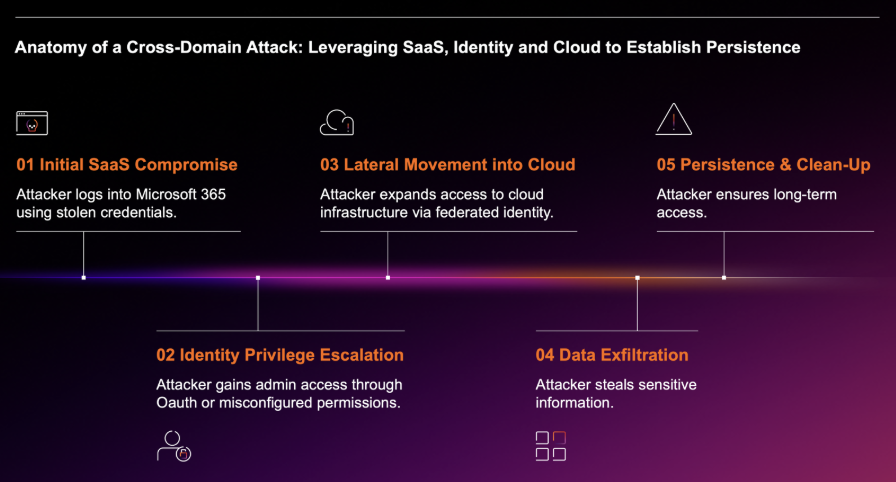Using leaked credentials to gain unauthorized access
Dark web marketplaces selling sensitive data have increased accessibility for malicious actors, similar to Ransomware-as-a-Service (RaaS), lowering the barrier to entry usually associated with malicious activity. By utilizing leaked credentials, malicious actors can easily gain unauthorized access to accounts and systems which they can leverage to carry out malicious activities like data exfiltration or malware deployment.
Usage of leaked credentials by malicious actors is a persistent concern for both organizations and security providers. Google Cloud’s ‘H1 2024 Threat Horizons Report’ details that initial access seen in 2.9% of cloud compromises observed on Google Cloud resulted from leaked credential usage [1], with the ‘IBM X-Force Threat Intelligence Index 2024’ reporting 71% year-on-year increase in cyber-attacks which utilize stolen or compromised credentials [2].
Darktrace coverage of leaked credentials
In early 2024, one Darktrace customer was compromised by a malicious actor after their internal credentials had been leaked on the dark web. Subsequent attack phases were detected by Darktrace/Network and the customer was alerted to the suspicious activity via the Proactive Threat Notification (PTN) service, following an investigation by Darktrace’s Security Operation Center (SOC).
Darktrace detected a device on the network of a customer in the US carrying out a string of anomalous activity indicative of network compromise. The device was observed using a new service account to authenticate to a Virtual Private Network (VPN) server, before proceeding to perform a range of suspicious activity including internal reconnaissance and lateral movement.
Malicious actors seemingly gained access to a previously unused service account for which they were able to set up multi-factor authentication (MFA) to access the VPN. As this MFA setup was made possible by the configuration of the customer’s managed service provider (MSP), the initial access phase of the attack fell outside of Darktrace’s purview.
Unfortunately for the customer in this case, Darktrace RESPOND™ was not enabled on the network at the time of the attack. Had RESPOND been active, it would have been able to autonomously act against the malicious activity by disabling users, strategically blocking suspicious connections and limiting devices to their expected patterns of activity.

Network Scanning Activity
On February 22, 2024, Darktrace detected the affected device performing activity indicative of network scanning, namely initiating connections on multiple ports, including ports 80, 161 389 and 445, to other internal devices. While many of these internal connection attempts were unsuccessful, some successful connections were observed.
Devices on a network can gather information about other internal devices by performing network scanning activity. Defensive scanning can be used to support network security, allowing internal security teams to discover vulnerabilities and potential entry points that require their attention, however attackers are also able to take advantage of such information, such as open ports and services available on internal devices, with offensive scanning.
Brute Force Login Attempts
Darktrace proceeded to identify the malicious actor attempting to access a previously unused service account for which they were able to successfully establish MFA to access the organization’s VPN. As the customer’s third-party MSP had been configured to allow all users to login to the organization’s VPN using MFA, this login was successful. Moreover, the service account had never previously been used and MFA and never been established, allowing the attacker to leverage it for their own nefarious means.
Darktrace/Network identified the attacker attempting to authenticate over the Kerberos protocol using a total of 30 different usernames, of which two were observed successfully authenticating. There was a total of 6 successful Kerberos logins identified from two different credentials. Darktrace also observed over 100 successful NTLM attempts from the same device for multiple usernames including “Administrator” and “mail”. These credentials were later confirmed by the customer to have been stolen and leaked on the dark web.

Even though MFA requirements had been satisfied when the threat actor accessed the organization’s VPN, Darktrace recognized that this activity represented a deviation from its previously learned behavior.
Malicious actors frequently attempt to gain unauthorized access to accounts and internal systems by performing login attempts using multiple possible usernames and passwords. This type of brute-force activity is typically accomplished using computational power via the use of software or scripts to attempt different username/password combinations until one is successful.
By purchasing stolen credentials from dark web marketplaces, attackers are able to significantly increase the success rate of brute-force attacks and, if they do gain access, they can easily act on their objectives, be that exfiltrating sensitive data or moving through their target networks to further the compromise.
Share Enumeration
Around 30 minutes after the initial network scanning activity, the compromised device was observed performing SMB enumeration using one of the aforementioned accounts. Darktrace understood that this activity was suspicious as the device had never previously been used to perform SMB activity and had not been tagged as a security device.

Such enumeration can be used by malicious actors to gain insights into the structures and configurations of a target device, view permissions associated with shared resources, and also view general identifying information about the system.
Darktrace further identified that the device connected to the named pipe “srvsvc”. By enumerating over srvsvc, a threat actor is able to request a list of all available SMB shares on a destination device, enabling further data gathering as part of network reconnaissance. Srvsvc also provides access to remote procedure call (RPC) for various services on a destination device.
At this stage, a Darktrace/Network Enhanced Monitoring model was triggered for lateral movement activity taking place on the customer’s network. As this particular customer was subscribed to the PTN service, the Enhanced Monitoring model alert was promptly triaged and investigated by the Darktrace SOC. The customer was alerted to the emerging activity and given full details of the incident and the SOC team’s investigation.
Attack and Reconnaissance Tool Usage
A few minutes later, Darktrace observed the device making a connection with a user agent associated with the Nmap network scanning tool, “Mozilla/5.0 (compatible; Nmap Scripting Engine; https://nmap.org/book/nse[.]html)”. While these tools are often used legitimately by an organization’s security team, they can also be used maliciously by attackers to exploit vulnerabilities that attackers may have unearthed during earlier reconnaissance activity.
As such services are often seen as normal network traffic, attackers can often use them to bypass traditional security measures. Darktrace’s Self-Learning AI, however, was able to recognize that the affected device was not a security device and therefore not expected to carry out such activity, even if it was using a legitimate Nmap service.

Further Lateral Movement
Following this suspicious Nmap usage, Darktrace observed a range of additional anomalous SMB activity from the aforementioned compromised account. The affected device attempted to establish almost 900 SMB sessions, as well as performing 65 unusual file reads from 29 different internal devices and over 300 file deletes for the file “delete.me” from over 100 devices using multiple paths, including ADMIN$, C$, print$.
Darktrace also observed the device making several DCE-RPC connections associated with Active Directory Domain enumeration, including DRSCrackNames and DRSGetNCChanges; a total of more than 1000 successful DCE-RPC connection were observed to a domain controller.
As this customer did not have Darktrace/Network's autonomous response deployed on their network, the above detailed lateral movement and network reconnaissance activity was allowed to progress unfettered, until Darktrace’s SOC alerted the customer’s security team to take urgent action. The customer also received follow-up support through Darktrace’s Ask the Expert (ATE) service, allowing them to contact the analyst team directly for further details and support on the incident.
Thanks to this early detection, the customer was able to quickly identify and disable affected user accounts, effectively halting the attack and preventing further escalation.
Conclusions
Given the increasing trend of ransomware attackers exfiltrating sensitive data for double extortion and the rise of information stealers, stolen credentials are commonplace across dark web marketplaces. Malicious actors can exploit these leaked credentials to drastically lower the barrier to entry associated with brute-forcing access to their target networks.
While implementing well-configured MFA and enforcing regular password changes can help protect organizations, these measures alone may not be enough to fully negate the advantage attackers gain with stolen credentials.
In this instance, an attacker used leaked credentials to compromise an unused service account, allowing them to establish MFA and access the customer’s VPN. While this tactic may have allowed the attacker to evade human security teams and traditional security tools, Darktrace’s AI detected the unusual use of the account, indicating a potential compromise despite the organization’s MFA requirements being met. This underscores the importance of adopting an intelligent decision maker, like Darktrace, that is able to identify and respond to anomalies beyond standard protective measures.
Credit to Charlotte Thompson, Cyber Security Analyst, Ryan Traill, Threat Content Lead
Appendices
Darktrace DETECT Model Coverage
- Device / Suspicious SMB Scanning Activity (Model Alert)
- Device / ICMP Address Scan (Model Alert)
- Device / Network Scan (Model Alert)
- Device / Suspicious LDAP Search Operation (Model Alert)
- User / Kerberos Username Brute Force (Model Alert)
- Device / Large Number of Model Breaches (Model Alert)
- Anomalous Connection / SMB Enumeration (Model Alert)
- Device / Multiple Lateral Movement Model Breaches (Enhanced Monitoring Model Alert)
- Device / Possible SMB/NTLM Reconnaissance (Model Alert)
- Anomalous Connection / Possible Share Enumeration Activity (Model Alert)
- Device / Attack and Recon Tools (Model Alert)
MITRE ATT&CK Mapping
Tactic – Technique - Code
INITIAL ACCESS - Hardware Additions -T1200
DISCOVERY - Network Service Scanning -T1046
DISCOVERY - Remote System Discovery - T1018
DISCOVERY - Domain Trust Discovery - T1482
DISCOVERY - File and Directory Discovery - T1083
DISCOVERY - Network Share Discovery - T1135
RECONNAISSANCE - Scanning IP Blocks - T1595.001
RECONNAISSANCE - Vulnerability Scanning - T1595.002
RECONNAISSANCE - Client Configurations - T1592.004
RECONNAISSANCE - IP Addresses - T1590.005
CREDENTIAL ACCESS - Brute Force - T1110
LATERAL MOVEMENT - Exploitation of Remote Services -T1210
References
- 2024 Google Cloud Threat Horizons Report
https://services.google.com/fh/files/misc/threat_horizons_report_h12024.pdf - IBM X-Force Threat Intelligence Index 2024
https://www.ibm.com/reports/threat-intelligence










































